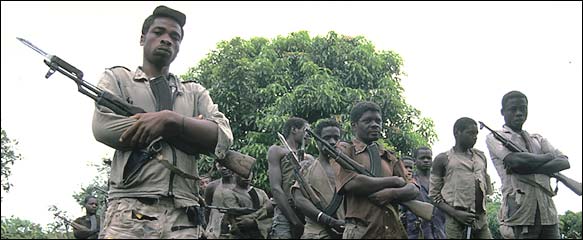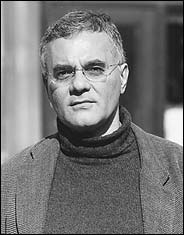| Want to send this page or a link to a friend? Click on mail at the top of this window. |
| Posted April 10, 2004 |
When U.S. Aided Insurgents, Did It Breed Future Terrorists? |
 |
Richard Hoffman/Corbis Sygma |
| Guerrillas from Renamo, The Mozambican National Resistance, above, in 1990. |
| By HUGH EAKIN |
In the varied explanations for the 9/11 attacks and the rise in terrorism, two themes keep recurring. One is that Islamic culture itself is to blame, leading to a clash of civilizations, or, as more nuanced versions have it, a struggle between secular-minded and fundamentalist Muslims that has resulted in extremist violence against the West. The second is that terrorism is a feature of the post-cold-war landscape, belonging to an era in which international relations are no longer defined by the titanic confrontation between two superpowers, the United States and the Soviet Union.
But in the eyes of Mahmood Mamdani, a Uganda-born political scientist and cultural anthropologist at Columbia University, both those assumptions are wrong. Not only does he argue that terrorism does not necessarily have anything to do with Islamic culture; he also insists that the spread of terror as a tactic is largely an outgrowth of American cold war foreign policy. After Vietnam, he argues, the American government shifted from a strategy of direct intervention in the fight against global Communism to one of supporting new forms of low-level insurgency by private armed groups.
"In practice," Mr. Mamdani has written, "it translated into a United States decision to harness, or even to cultivate, terrorism in the struggle against regimes it considered pro-Soviet." The real culprit of 9/11, in other words, is not Islam but rather non-state violence in general, during the final stages of the stand-off with the Soviet Union. Using third and fourth parties, the C.I.A. supported terrorist and proto-terrorist movements in Indochina, Latin America, Africa and, of course, Afghanistan, he argues in his new book, "Good Muslim, Bad Muslim: America, the Cold War and the Roots of Terror" (Pantheon).
"The real damage the C.I.A. did was not the providing of arms and money," he writes, " but the privatization of information about how to produce and spread violence — the formation of private militias — capable of creating terror." The best-known C.I.A.-trained terrorist, he notes dryly, is Osama bin Laden.
Other recent accounts have examined the ways in which American support for the mujahedeen in the 1980's helped pave the way for Islamic terrorism in the 90's. But Mr. Mamdani posits a new — and far more controversial — thesis by connecting the violent strain of Islam to a broader American strategy.
"Mahmood's argument is that terrorism is a defining characteristic of the last phase of the cold war," said Robert Meister, a political scientist at the University of California, Santa Cruz, who has followed Mr. Mamdani's work for three decades. He added, "It was a characteristic that took on, especially in Africa, a logic of its own, a logic that eventually broke free of the geopolitics that started it."
In a telephone interview from Kampala, Uganda, where he has a second home, Mr. Mamdani explained, "What I have in mind is the policy of proxy war." As his book recounts, the African continent became a major front in the cold war after the rapid decolonization of the 1960's and 70's gave rise to a number of nationalist movements influenced by Marxist-Leninist principles.
For the United States, caught in the wave of antiwar feeling set off by Vietnam, the only way to roll back this process was to give indirect support to violent new right-wing groups. Mr. Mamdani asserts, for example, that the United States policy of constructive engagement with apartheid in South Africa helped sustain two proto-terrorist organizations — Unita, the National Union for the Total Independence of Angola, and Renamo, the Mozambican National Resistance — that were armed and trained by the South African Defense Force. Renamo became what Mr. Mamdani calls Africa's "first genuine terrorist movement," a privatized outfit that unleashed random violence against civilians without any serious pretension to national power.
 |
Sipa Press |
| The political scientist Mohamood Mamdani |
In the 1980's, Mr. Mamdani argues, the American use of proxy forces became increasingly overt. "What had begun as a very pragmatic policy under Kissinger was ideologized by the Reagan administration in highly religious terms, as a fight to the finish against the `Evil Empire,' " Mr. Mamdani said.
Drawing on the same strategy used in Africa, the United States supported the Contras in Nicaragua and then created, on a grand scale, a pan-Islamic front to fight the Soviets in Afghanistan. Whereas other Islamic movements, like the Iranian revolution, had clear nationalist aims, the Afghan jihad, Mr. Mamdani suggests, was created by the United States as a privatized and ideologically stateless resistance force.
A result, he writes, was "the formation of an international cadre of uprooted individuals who broke ties with family and country of origin to join clandestine networks with a clearly defined enemy."
According to Mr. Mamdani, the strategy of proxy warfare continued even after the collapse of the Soviet Union, as the United States looked for new ways to sponsor low-intensity conflicts against militantly nationalist regimes. In a final section on the current conflict in Iraq, the book suggests that it, much more than the end of the cold war in 1989, closed the "era of proxy warfare" in American foreign policy.
Scholars familiar with the book say that Mr. Mamdani's account of the late cold war, and its emphasis on Africa in particular, is likely to be disdained by specialists on Islam, some of whom are criticized by name in the opening chapter.
"The book is most original in the skewer it puts through what Mamdani calls the `culture talk' that has substituted for serious explanations of political Islam," said Timothy Mitchell, a political scientist at New York University. "Scholar-pundits like Bernard Lewis and Fouad Ajami tell us that the culture of Muslims or Arabs cannot cope with modernity. Mamdani shows us that the origins of political Islam are themselves modern, and, in fact, largely secular."
But John L. Esposito, a Georgetown University expert on political Islam, warns that an attempt to explain Islamic terrorism through international politics alone risks the same flaw as the cultural approach. "To say it's simply politics, without taking into account religion, misses the causes behind a lot of these conflicts, just as the reverse misses them," he said. "It's religion and politics together."
Mr. Mamdani's unusual perspective is partly a result of his own experience in Africa. A third-generation East African of Indian descent, Mr. Mamdani, 57, grew up in the final years of colonial Uganda.
"Idi Amin was my first experience of terror, and I understood how a demagogue could ride a wave of popular resentment," Mr. Mamdani said, recalling how he and other Asians were expelled in 1972.
After completing a Ph.D. at Harvard in 1974, he took a faculty position at the University of Dar es Salaam in Tanzania, at the time a hotbed of radical African politics. Among his colleagues were the future Ugandan president Yoweri Museveni, as well as Laurent Kabila, the future president of Congo, and Ernest Wamba dia Wamba, leader of one of the revolutionary factions against Kabila.
Mr. Mamdani returned to Uganda during the civil war that ousted Amin and took a deanship at the national university in Kampala, where he became a leading expert on agrarian administration and its relation to post-colonial unrest. Often outspoken against the Ugandan government, he was exiled a second time in 1985, during another civil war. In the late 1980's, he led a Ugandan commission on local government; later he taught at the University of Cape Town in South Africa during the tumultuous early years after apartheid.
His previous book, "When Victims Become Killers: Colonialism, Nativism and the Genocide in Rwanda," sought to overturn the view that those atrocities had deep tribal roots. Much of the Hutu-Tutsi ethnic rivalry, he argued, could be traced to the colonial period. (The Belgians had introduced and enforced Hutu and Tutsi racial identities in a segregated social system.)
Mr. Mamdani, who now directs Columbia's Institute for African Studies, lives in New York and Kampala with his wife, the Indian filmmaker Mira Nair, and their son.
To understand political Islam, Mr. Mamdani says Africa's experience is instructive. "Africa is seen as exceptional, as not even part of the rest of the world," he said. "But on the contrary, it's an illuminating vantage point."
Copyright 2004 The New York Times Company. Reprinted from The New York Times, Arts & Ideas, of Saturday, April 10, 2004.
| Wehaitians.com, the scholarly journal of democracy and human rights |
| More from wehaitians.com |